

| Online: | |
| Visits: | |
| Stories: |

| Story Views | |
| Now: | |
| Last Hour: | |
| Last 24 Hours: | |
| Total: | |
Proper Nursery Plant Tagging.
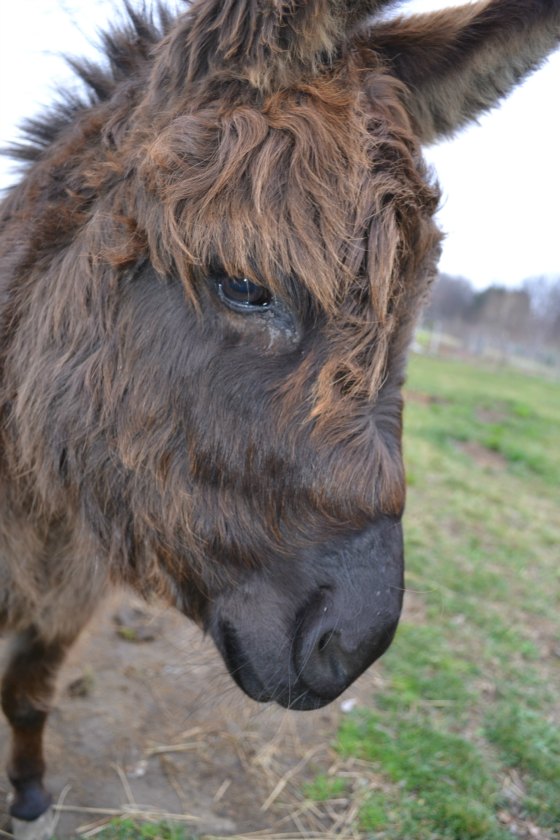
Fergus the miniature donkey looking on to make sure I tag my plants properly.
Even Fergus knows how important proper plant tagging is. Lately we’ve been sticking thousands of hardwood cuttings right along the Donkey Fence and let’s face it, right now they all look like sticks so making sure they are properly tagged is extremely important.
There are a couple of things you need to know about tagging plants in a nursery.
- It’s the law. Anytime you sell a plant to anybody, retail customer, wholesale customer, mail order customer, that plant has to be properly tagged.
- When selling a bundle of plants, or a flat of plants, you can usually get away with just one tag. In most states each plant, or each unit of plants has to be tagged. A bundle of bare root plants that are securely tied constitute “a unit” of plants, thus one tag per bundle.
- In most states they ask that you tag the plant with the accepted common name, the botanical name or both. Obviously putting both the accepted common name and the botanical name on the tag makes the most sense. But it is also the most time consuming and a tad difficult if you are hand writing your tags. Therefore, in our retail nursery we only tag with the common name most of the time because we use very Descriptive Bench Cards to help sell our plants.
- You can’t guess at plant names! You can’t assume that you know the plant is a Japanese Holly because your dad or your grandmother told you so. There are way too many varieties and cultivars of plants that are very similar yet different. In Our Members Area, everybody is very, very familiar of my rant about properly named plants. I suggest you read the rant that I show to them on a regular basis.
To give you an idea why I am so adamant about this just recently I discovered that a rose of sharon that I have been growing for a number of years now appears to have been mis-tagged by the person whom I bought it from. Doing some recent research I googled the plant and found that the photos being displayed on the webpage of a main stream wholesale nursery that I very much trust to be 100% accurate with their plant identifications were very much different than the plant that I have!
I can’t even begin to tell you how frustrating this is!!!
There are two things about this that I know for sure.
- I will never know for sure what variety of rose of sharon I have and have been growing. At this point that would be impossible. Sure I can look at photos, but it would still be a guess and that’s a huge, huge problem.
- I will have to buy several hundred of the one that I thought I was growing from a reputable source so I can begin propagating the right plant. Providing it’s not patented. More about that in a bit.
But do you see how frustrating and aggravating this plant tagging thing can be?
What if I had sold several hundred of those to a landscape contractor to use on a commercial job. Say the grounds of a university that just happens to have a horticultural school! I could be in big, big trouble because if the plants are not as specified the landscape architect that designed the landscape could order them to be removed and replaced.
I would be on the hook for new plants, labor and reclaiming the school grounds. Plus damages I’m sure.
This is serious business and I hope you take it that seriously.
You have to absolutely, positively know the correct common and botanical name of the plants that you are selling. They only way to obtain that information is have been given it on the day that you purchased your plants.
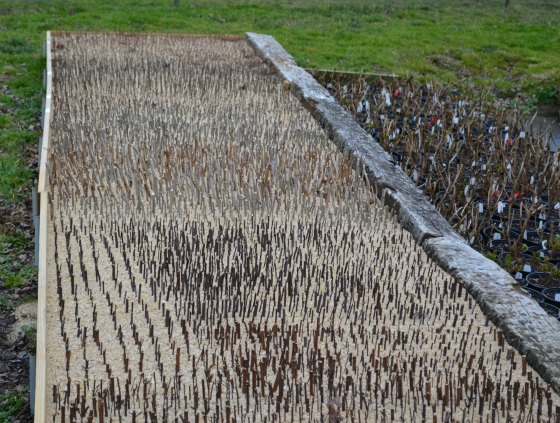
Thousands of hardwood cuttings in a bed.
We just stuck these hardwood cuttings. (Dec. 2015) Looks like a sea of unidentifiable sticks right? So how do I keep them straight? I do two things. One, I make a map of the bed as we stick the cuttings that looks like this, and this is the actual map of this bed.
************************************************************************************************************
South End. 2015-2016 Hardwood Cutting Bed
Pink Whisper Potentilla
Blue Artic Willow
Gold Finger Potentilla
Blushing Bride Rose of Sharon
Annabelle Hydrangea
Rose of Sharon Aphrodite
Purple Sandcherry
Snowmound Spirea
Ruby Rose of Sharon
Pink Pussy Willow
Dappled Willow
Golden Curls Willow
Weeping Pussy Willow
Red Twig Dogwood
North End.
************************************************************************************************************
The actual map is hand written on a small legal pad. Then I simply file this map in my folder of “nursery maps”.
Hardwood cutting season begins in November and ends in March that’s why the map is dated 2015-2016.
The second thing that I do is I use Aluminum Plant Tags as you see below. I use these Aluminum tags because the name of the plant is pressed into the tag and cannot fade away. However, they still can be a little tricky to read a year later, especially if you write like me. Thus the map just in case I need it.
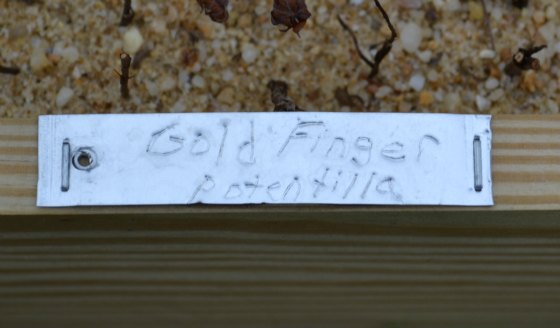
Hand written aluminum plant tags.
I staple the aluminum tags on the wood frame next to the appropriate block of cuttings. This works for me because we always make several hundred cuttings of each variety. We usually get about 50 cuttings to a row.
We don’t leave any space between our varieties of cuttings because as we pull the cuttings we are able tell them apart and I don’t want to waste the space. But if you look at the map of this bed you’ll notice that we don’t stick cuttings that look identical next to each other. For instance Pink Whisper Potentilla and Gold Finger Potentilla look almost identical unless they are in bloom. So we stick something that looks like neither one in between them. That way we can’t mix them up as we pot them.
When we pot up our plants we tag every single plant with a stick tag that looks like this;

Plastic stick tag for tagging potted plants.
I use these stick tags for a number of different reasons.
- They are relatively inexpensive. I think I’m paying around two cents each. When you buy 30,000 or 40,000 at a time those pennies really add up.
- Sticking these tags in a pot is fairly easy and it can be done quickly. Trust me, it’s something you don’t think about but every second counts when you have thousands and thousand of plants to pot, fertilize, tag and place in the nursery. Speed is everything. Wasted time wrestling with a cumbersome tag is frustrating!
- Since we do so many of these tags I purchased a tag printer that can print hundreds of tags in just a minute or two. Again, hand writing tags isn’t the worst job in the world, but it is a time consuming task, and hand written tags can fade if you use the wrong writing instrument.
The tag printer was an investment, but it is such a time saver it’s some of the best money that I’ve spent. For years and years my wife has, and still hand writes some tags when we need a tag that won’t go through the printer.
This is the printer that I use;

Plastic strip tag for plants.
This is a plastic strip tag. This is often the kind of tag that you might want to use if you are hand writing your tags because it gives you more writing area. This tag wraps around a branch and the end slips through the loop securely attaching the tag to the plant. Obviously we put these on our Lavender Twist Weeping Redbud Trees and we also use them on many of our Japanese Maples.
A few more points about this particular tag . . .
- This tag indicates that the Lavender Twist Weeping Redbud Tree is patented. Right after the botanical name you’ll see the patent number. PP # 10328. That means that it is against the law to propagate this tree unless you purchase a license from the patent holder and if you are not going to do thousands and thousands of them it’s not worth it. Most licenses start at $1,000 per plant and you still have to pay a royalty on each plant that you grow and sell.
- The little ™ after the name of the plant indicates that the owner of the patent has applied for a trademark on the name of the plant. I’m guessing that the trademark has now been issued so a tag like this should now display the ® symbol.
- Plant patents expire 20 years from date of application. But the trademark can be renewed and last forever.
- It’s against the law to propagate a patented plant, but it’s not against the law to sell a patented plant as long as you paid the royalties that were due when you purchased your plants. I buy these Lavender Twist Redbuds from a grower on the west coast. At the time of purchase I paid a one dollar royalty on each tree that I bought and I was also required to buy these special tags so when I sell the trees, the purchaser knows that the plant is patented and the name is trademarked.
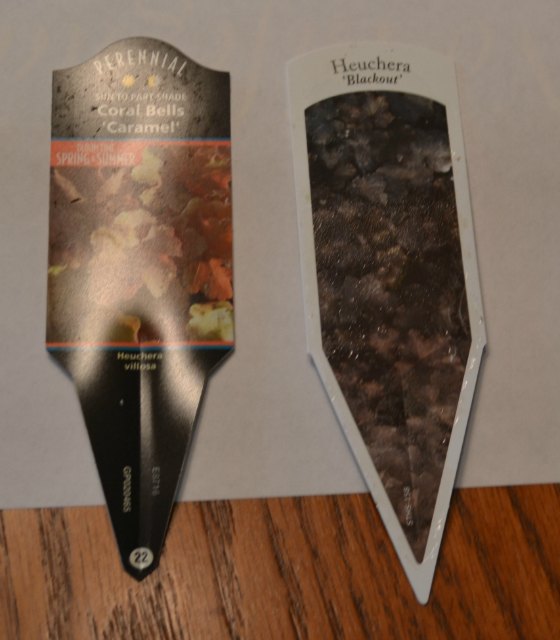
Color picture tags for patented coral bells.
Pretty much the same story on these two tags. I purchased several hundred patented heuchera. ‘Blackout’ and ‘Caramel’. Because these cultivars are patented I had to pay a royalty on each plant that I purchased and I also had to buy these color stick tags.
I don’t remember exactly what I paid but it seems to me that the tag and royalty added about 25 or 30 cents to the price of each plant that I bought. Not a big deal as far as I’m concerned. I only look at the bottom line and I know that I paid about $2.75 per plant altogether and I’ll sell them months later for $5.97 each and really I could charge a lot more if I wanted to.
The back of these tags also tell a story.
On the back of the tag you can see the plant patent number, the registered trademark symbol and the admonishment about the legality of propagating this plant. Along with important information about the plant that a customer wants to know. Sun, shade, hardiness zone and all of that.
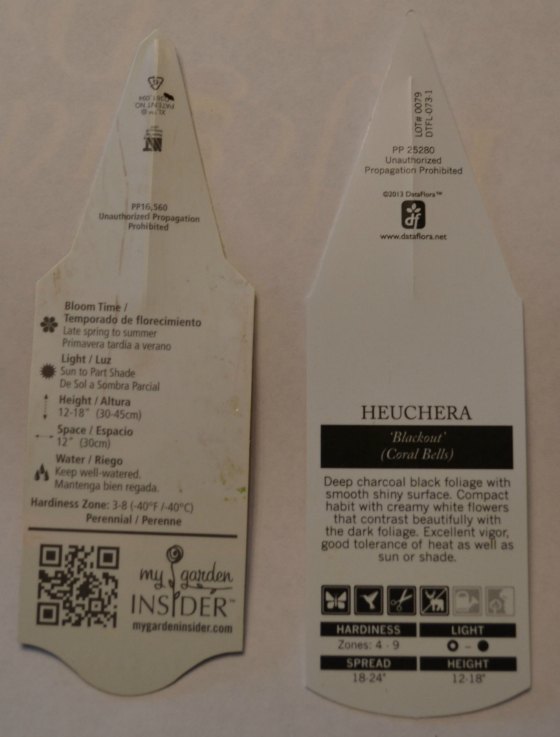
The back of a plant stick tag.
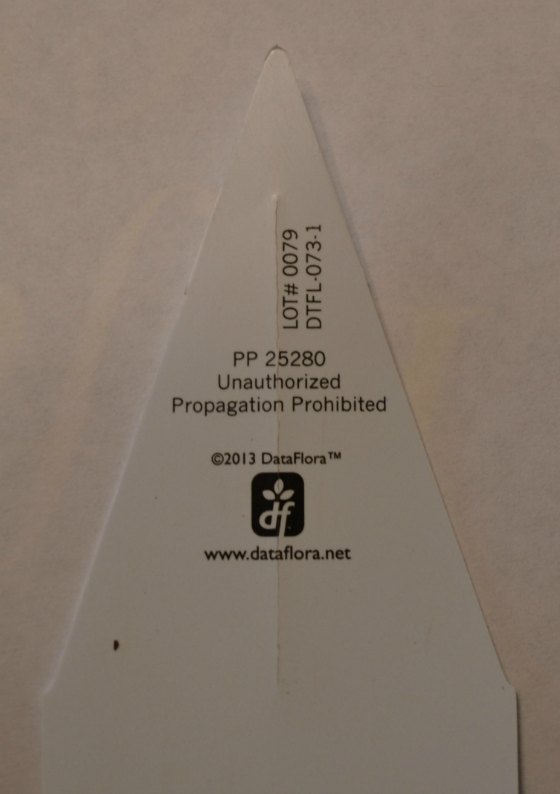
Plant tag displaying the “Do Not Propagate” notice.
It’s important to know what you are looking at when you look at one of these plant tags.
The numbers at the very top of the picture I believe to be inventory numbers for the plant tag itself and having nothing to do with the plant. That’s why they are printed perpendicular to the rest of the text on the tag.
Right above “Unauthorized Propagation Prohibited” notice is the plant patent number.
The text below the “Unauthorized Propagation” notice also have nothing to do with the plant but pertain to the plant tag. The plant tag is copyrighted, see the © symbol? Plants are not copyrighted, but plant tags are. It would be against the law to make copies of this plant tag. There is also a ™ symbol after the words DataFlora indicating that they have applied for a trademark on the name of their company.
That’s all important information, but most importantly, know what applies to the plant, and what applies to the plant tag.
Hand Writing Plant Tags.
There is nothing wrong with handwriting plant tags. It might be a tad unprofessional, but nobody that you are going to sell to really cares about that. They know you are small, they know that you have to make do with what you have. They want nice plants, they really don’t care that you hand wrote the tag.
In most cases they are elated to be able to buy from an actual grower and not a “big box” or a garden center that just “brokers” plants. Never lose sight of how important you are to your customers. They love you, the admire you for what you do, they admire you for what you know, and they are in awe of what you’ve accomplished.
You can take that to the bank!
And most of the time they are envious because you get to do what you do. They might be locked in a cubical all day. That’s why I always include these two crazy donkeys in my posts. People love them and some are envious and wish that they could share a hammock with a couple of Whackadoodle Donkeys.

The donkeys never leave me alone when I’m in the hammock. Nor would I want them to.

Finnegan hugs me almost everyday. Fergus? He does but he’s always been a bit more standoffish.
and now a quiz!
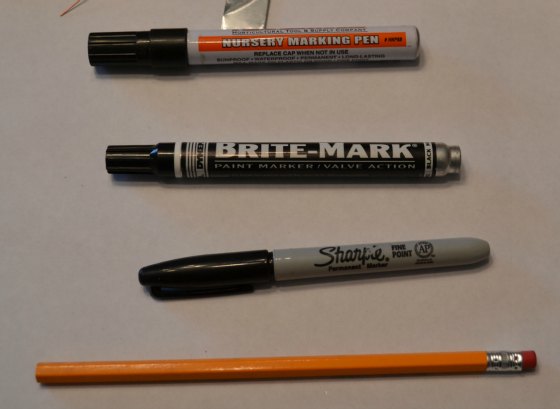
Plant marking pens and pencils.
Which of these do you think works the best for marking plant tags?
The top one is a “nursery marking pen”. They work okay but they are not as permanent as many people want them to be. Growers often go out into the nursery to find tags they can no longer read. And the tip is a bit wide and difficult to write with on a plant tag.
The second one is a paint marker. It contains paint, not ink. A lot more permanent, but even more difficult to write with.
The third one is a permanent marker. Much easier to write with if you get the fine point one, but still not as permanent as you would expect when out in the elements. I Hear from Members All the Time about faded plant tags and how frustrating that is.
Believe it or not, the forth item in photo, the old fashioned #2 pencil works pretty darn good for writing on plant tags and often holds up in the elements better than many other markers.
What’s better than a #2 pencil?
An Indelible Pencil that’s what!
What is an Indelible Pencil? It’s pencil that was invented around 1870 used for making very permanent copies of important documents. Ink is added to the graphite before the pencil is made. If you search for indelible pencil you can find them on amazon and other places online.
What about making tags with a laser printer?
You can. You absolutely can print tags on a laser printer and many of Our Members do. I tried it before investing in the tag printer that you see here. For me, it was a very frustrating experience. Seems to me the laser tags, which come in a sheet, cost about 8 cents per tag. That’s a lot more expensive than the 2 or 3 cents that I am now paying for my pot sticker tags.
Secondly, the laser printer hated me. The stupid thing would get hot, shut down and it seemed like we were always waiting for the tags to print. I have a couple of part-time employees in the nursery and when you are paying people by the hour you don’t want them standing around starring at a printer wondering when the next tag is coming out. Especially at the peak of the potting season when you have a million things going on.
The third issue that I had with the laser printer tags is that they have to be thin to go through that kind of a printer. That makes them flimsy and tricky to stick in a pot. Anything that slows people down has to seriously be re-considered.
Our Members have a knack for finding and sharing the most awesome wholesale suppliers around so if you are looking to buy some blank tags, ask that question in the members area. If you are not a member, look on Amazon or Ebay, I think you can find some there.
Now, that’s my story about tagging plants. I know many of you have plant tagging strategies that you’d like to share, please do that below.
Also, I talked a lot about patented plants in this article. If you have questions about that, See this Article on Growing and Selling Patented Plants.
Post your questions and comments below.
Source: http://mikesbackyardnursery.com/2016/01/proper-nursery-plant-tagging/


